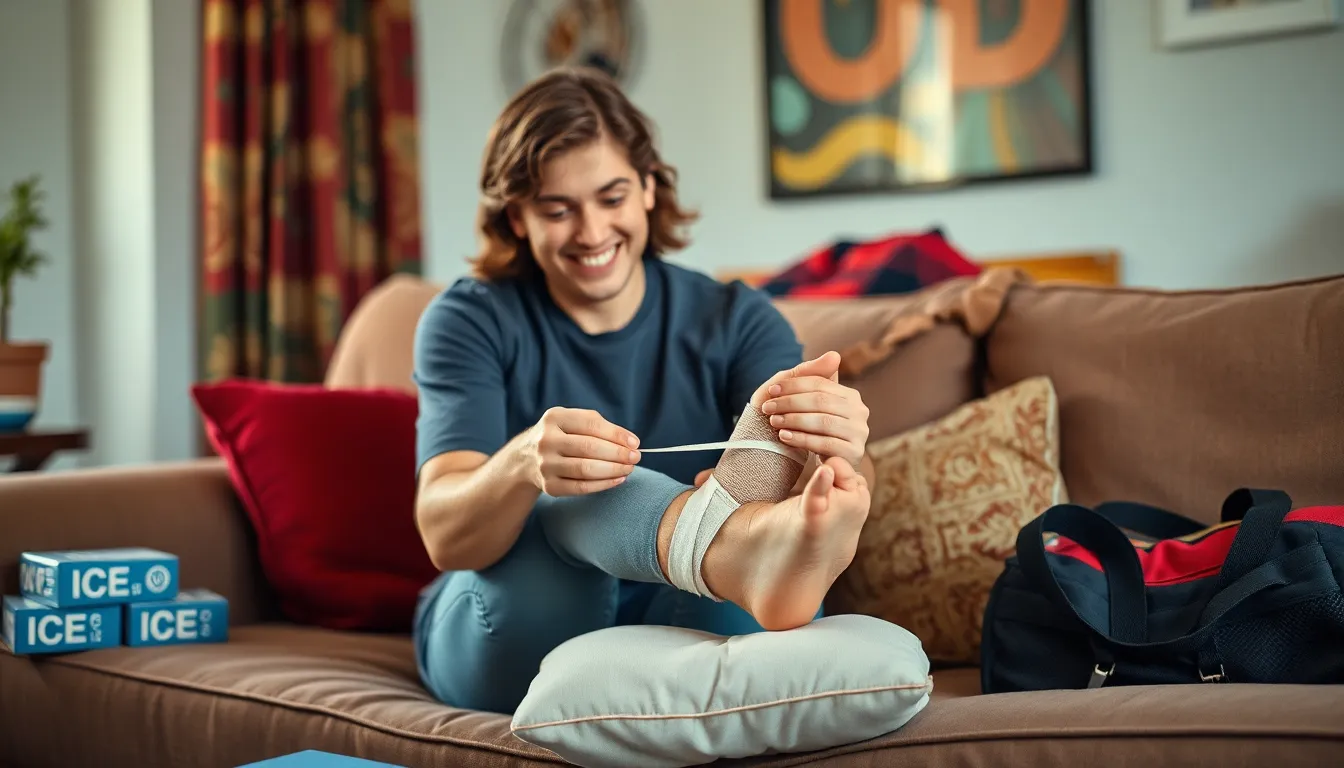Table of Contents
ToggleAnkle sprains can feel like a cruel joke played by the universe, turning a simple walk into an unplanned audition for a role in a slapstick comedy. When that unfortunate twist happens, the question arises: should you wrap that sprained ankle overnight? It’s a valid concern, especially when you’re trying to avoid turning your foot into a balloon animal while you sleep.
Understanding Ankle Sprains
Ankle sprains involve damage to the ligaments surrounding the ankle joint. These injuries can result in pain, swelling, and difficulty bearing weight on the affected leg.
What Is a Sprained Ankle?
A sprained ankle occurs when ligaments in the ankle stretch beyond their limits or tear. Injury severity varies, ranging from mild strains to complete tears. Common symptoms include pain, swelling, bruising, and instability in the joint. Medical professionals often classify sprains into three grades. Grade one indicates mild stretching, grade two signifies partial tears, and grade three refers to complete rupture of the ligament.
How Do Sprained Ankles Occur?
Ankle sprains frequently happen during physical activities, especially sports. Missteps, uneven surfaces, or sudden changes in direction often result in these injuries. Incorrect landings after jumps or awkward movements can cause the ankle to roll, leading to ligament stress. Individuals may also sprain their ankles while walking or running on uneven terrain. These sprains are among the most common injuries in athletes and active individuals.
Benefits of Wrapping a Sprained Ankle

Wrapping a sprained ankle offers significant benefits, including compression, support, and reduced swelling. These advantages can facilitate recovery and improve comfort during healing.
Compression and Support
Compression enhances stability around the injured area. A well-wrapped ankle provides essential support, limiting excessive movement that could exacerbate the injury. Proper wrapping techniques ensure firm yet gentle pressure, promoting protection against further strain. Ankle wraps also help maintain proper alignment of ligaments during activity. As a result, athletes often experience a better range of motion within safe limits. Using elastic bandages or specialized wraps maximizes these benefits, significantly aiding the healing process.
Reducing Swelling
Reducing swelling is another crucial benefit. Wrapping an ankle helps restrict blood flow to the injured ligaments, minimizing inflammation. Inflammation reactions often lead to increased discomfort and hinder recovery. An effective wrap helps manage this response by providing controlled pressure. Applying the wrap immediately after injury can yield better outcomes in swelling reduction. Elevating the ankle while wrapped further amplifies this effect. Overall, ensuring a proper fit and tension level promotes optimal circulation while addressing symptoms.
Risks of Wrapping a Sprained Ankle Overnight
Wrapping a sprained ankle overnight poses various risks that individuals should consider for effective recovery and healing.
Impaired Circulation
Impaired circulation can occur when an ankle is tightly wrapped overnight. Blood flow may reduce, leading to discomfort and potential additional complications. Lack of sufficient blood flow impedes healing by preventing essential nutrients from reaching the injured area. Swelling often worsens with restricted circulation, leading to increased pain and prolonged recovery times. Recognizing symptoms such as numbness or tingling signifies the wrap may be too tight. A well-wrapped ankle should feel secure but not constrictive, ensuring proper blood flow and promoting healing.
Excessive Compression
Excessive compression from wrapping an ankle too tightly can lead to complications. Increased pressure may cause further damage to the ligaments and surrounding tissues. Pain can intensify, and the risk of additional injuries rises. Ankle mobility may also decrease, complicating rehabilitation efforts. Compression should offer support without restricting movement unduly. Striking a balance prevents excessive compression and allows the body to heal effectively. Monitoring comfort levels is vital, as discomfort or excessive tightness indicates improper wrapping techniques. Proper technique ensures that support meets healing needs without compromising circulation.
Alternatives to Wrapping
Exploring alternatives to wrapping a sprained ankle can provide effective relief and support during recovery.
Using Ice and Elevation
Applying ice is essential for managing pain and swelling in a sprained ankle. Ice reduces blood flow to the area, which minimizes inflammation. Use cold packs for 15 to 20 minutes at a time, every few hours during the first 48 hours. Elevating the ankle above heart level complements ice therapy and facilitates drainage of excess fluid, reducing swelling significantly. Combining these two methods promotes a safer and more comfortable recovery experience while minimizing the risks associated with wrapping.
Ankle Braces and Supports
Ankle braces offer a convenient alternative to traditional wrapping methods. These supports provide stability to the joint while allowing for necessary movement. It’s crucial to choose adjustable braces to ensure a proper fit without excessive compression. Many braces include padded areas to enhance comfort and protection. In addition, using supports can aid in maintaining alignment and prevent further injury during daily activities. Incorporating braces into the recovery plan ensures greater flexibility and quality care for a sprained ankle.
Wrapping a sprained ankle overnight can offer benefits like compression and support but also carries risks that shouldn’t be overlooked. It’s essential to find the right balance to promote healing without compromising circulation. Monitoring comfort levels is crucial to avoid complications that could hinder recovery.
Incorporating ice and elevation alongside wrapping can enhance the recovery process. Exploring alternatives like ankle braces may provide additional stability without the risks associated with tight wrapping. By understanding these factors, individuals can make informed decisions that facilitate a smoother healing journey for their sprained ankle.






